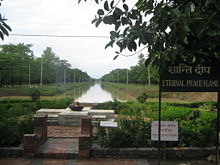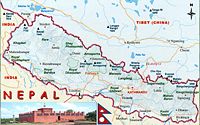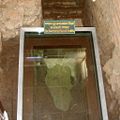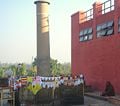Lumbini
| Lumbini, the Birthplace of the Lord Buddha* | |
|---|---|
| UNESCO World Heritage Site | |

| |
| State Party | |
| Type | Cultural |
| Criteria | iii, vi |
| Reference | 666 |
| Region** | Asia-Pacific |
| Inscription history | |
| Inscription | 1997 (21st Session) |
| * Name as inscribed on World Heritage List. ** Region as classified by UNESCO. | |
Lumbini (Sanskrit: लुम्बिनी, "the lovely") is a Buddhist pilgrimage site in the Kapilavastu district of Nepal, near the Indian border.[1] Buddhist tradition marks Lumbini as the place where Queen Mayadevi gave birth to Siddhartha Gautama. Siddhartha, as the Buddha Gautama, founded the Buddhist tradition by his teachings and life between approximately 563 and 483 B.C.E.
Lumbini is one of four magnets for pilgrimage that sprang up in places pivotal to the life of the Buddha, the others being at Kushinagar, Bodh Gaya, and Sarnath. Lumbini is in the foothills of the Himalaya, [2] twenty five kilometers east of the municipality of Kapilavastu, where tradition says that the Buddha lived until the age of 29. Kapilvastu is the name of the place as well as of the neighboring district. Lumbini has a number of temples, including the Mayadevi temple, and others under construction. Also Lumbini is the location of Puskarini (or Holy Pond) where the Buddha's mother took the ritual dip prior to his birth and where he, too, had his first bath. The remains of Kapilvastu palace are found there as well. At sites near Lumbini, according to tradition, earlier Buddhas were born, achieved ultimate awakening, and finally relinquished earthly form.
Lumbini in Buddha's time
| Pilgrimage to Buddha's Holy Sites |

|
| The Four Main Sites |
|---|
| Lumbini · Bodh Gaya Sarnath · Kushinagar |
| Four Additional Sites |
| Sravasti · Rajgir Sankissa · Vaishali |
| Other Sites |
| Patna · Gaya Kausambi · Mathura Kapilavastu · Devadaha Kesariya · Pava Nalanda · Varanasi |
In the Buddha's time, Lumbini was a park situated between Kapilavatthu and Devadaha.[3] It was there that the Buddha was born[4]. A pillar now marks the spot of Asoka's visit to Lumbiní. According to an inscription on the pillar, it was placed there by the people then in charge of the park to commemorate Asoka's visit and gifts[5]. The park was previously known as Rummindei, two miles north of Bhagavanpura.
In the Sutta Nipáta (vs. 683) it is stated that the Buddha was born in a village of the Sákyans, in the Lumbineyya Janapada. The Buddha stayed in Lumbinívana during his visit to Devadaha and there preached the Devadaha Sutta[6].
Re-discovery of the site of Lumbini
In 1896, Nepalese archaeologists (effort by Khadga Samsher Rana) discovered a great stone pillar at the site, attributed to Emperor Ashoka.[7] Records made by the Chinese pilgrim Fa Xian were also used in the process of identifying this religiously acclaimed site.
Current Lumbini
Lumbini, as of 1997, is an UNESCO World Heritage Site specifically nominated for the international World Heritage program.
The holy site of Lumbini is bordered by a large monastic zone, in which only monasteries can be built, no shops or hotels or restaurants.[8] It is separated into an eastern and western monastic zone, the eastern having the Theravadin monasteries, the western having Mahayana and Vajrayana monasteries.
The holy site of Lumbini has ruins of ancient monasteries, a sacred Bodhi tree, an ancient bathing pond, the Asokan pillar and the Mayadevi temple, where the precise place of birth of Buddha is located. From early morning to early evening, pilgrims from various countries perform chanting and meditation at the site.
|
History of Buddhism Foundations Key Concepts Major Figures Practices Regions Branches Texts | |
Gallery
See Also
Notes
- ↑ D. C. Ahir. 2003. Buddhist sites and shrines in India: history, art, and architecture (Delhi: Sri Satguru Publications), p. 276
- ↑ Buddhist Temples India
- ↑ Subbiah Muthiah. 1990. Where the Buddha walked. A TTK guidebook (Madras: TT Maps & Publ.), p. 19
- ↑ J.i.52, 54; Kvu.97, 559; AA.i.10; MA.ii.924; BuA.227; Cv.li.10. Buddha. Retrieved September 28, 2008.
- ↑ Radhakumud Mukerji. 1962. Asoka (Delhi: Motilal Banarsidass), p. 27, 201f
- ↑ MA.ii.810 Buddha. Retrieved September 28, 2008.
- ↑ Sunita Dwivedi. 2006. Buddhist heritage sites of India. (New Delhi: Rupa & Co.), p. 9
- ↑ Anagarika Dharmapala. 1892. The Maha Bodhi ([Calcutta, etc.]: Maha-Bodhi Society) Item notes: v.102:1-4 (1994).
ReferencesISBN links support NWE through referral fees
- Ahir, D. C. 2003. Buddhist sites and shrines in India: history, art, and architecture. Delhi: Sri Satguru Publications. ISBN 9788170307747.
- Deeg, Max. 2003. The places where Siddhārtha trod: Lumbinī and Kapilavastu. Lumbini: Lumbini International Research Institute. ISBN 9789993376989.
- Dwivedi, Sunita. 2006. Buddhist heritage sites of India. New Delhi: Rupa & Co. ISBN 9788129107381.
- Mukerji, Radhakumud. 1962. Asoka. Delhi: Motilal Banarsidass. OCLC 59685786.
- Rijal, Babu Krishna. 1979. Archaeological remains of Kapilavastu, Lumbini, and Devadaha. Kathmandu: Educational Enterprises. OCLC 9819499.
External links
- Entry on Lumbini in the Dictionary of Pali Proper Names. Retrieved September 28, 2008.
- WelcomeNepal.com: Lumbini - Places to see. Retrieved September 28, 2008.
- Buddhist studies: Pilgrimage: Lumbini - Birthplace of the Buddha. Retrieved September 28, 2008.
- Buddha. Retrieved September 28, 2008.
- Bhaktivedanta VedaBase Network. Retrieved September 29, 2008.
- Timeless Lumbini Buddha’s Birthplace. Retrieved September 29, 2008.
| |||||||||||||||||||||||||||||||||||||||||||
Credits
New World Encyclopedia writers and editors rewrote and completed the Wikipedia article in accordance with New World Encyclopedia standards. This article abides by terms of the Creative Commons CC-by-sa 3.0 License (CC-by-sa), which may be used and disseminated with proper attribution. Credit is due under the terms of this license that can reference both the New World Encyclopedia contributors and the selfless volunteer contributors of the Wikimedia Foundation. To cite this article click here for a list of acceptable citing formats.The history of earlier contributions by wikipedians is accessible to researchers here:
The history of this article since it was imported to New World Encyclopedia:
Note: Some restrictions may apply to use of individual images which are separately licensed.











